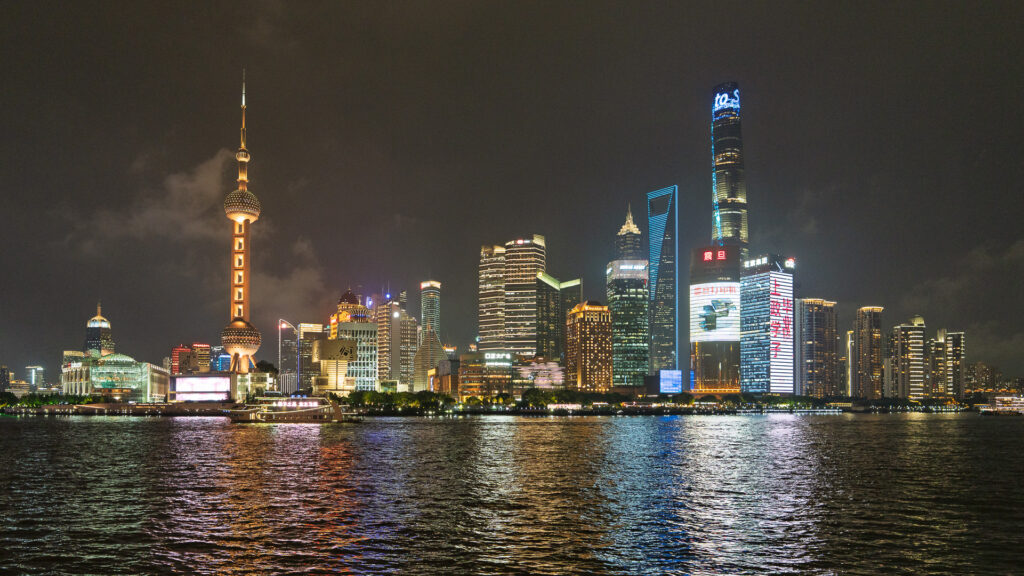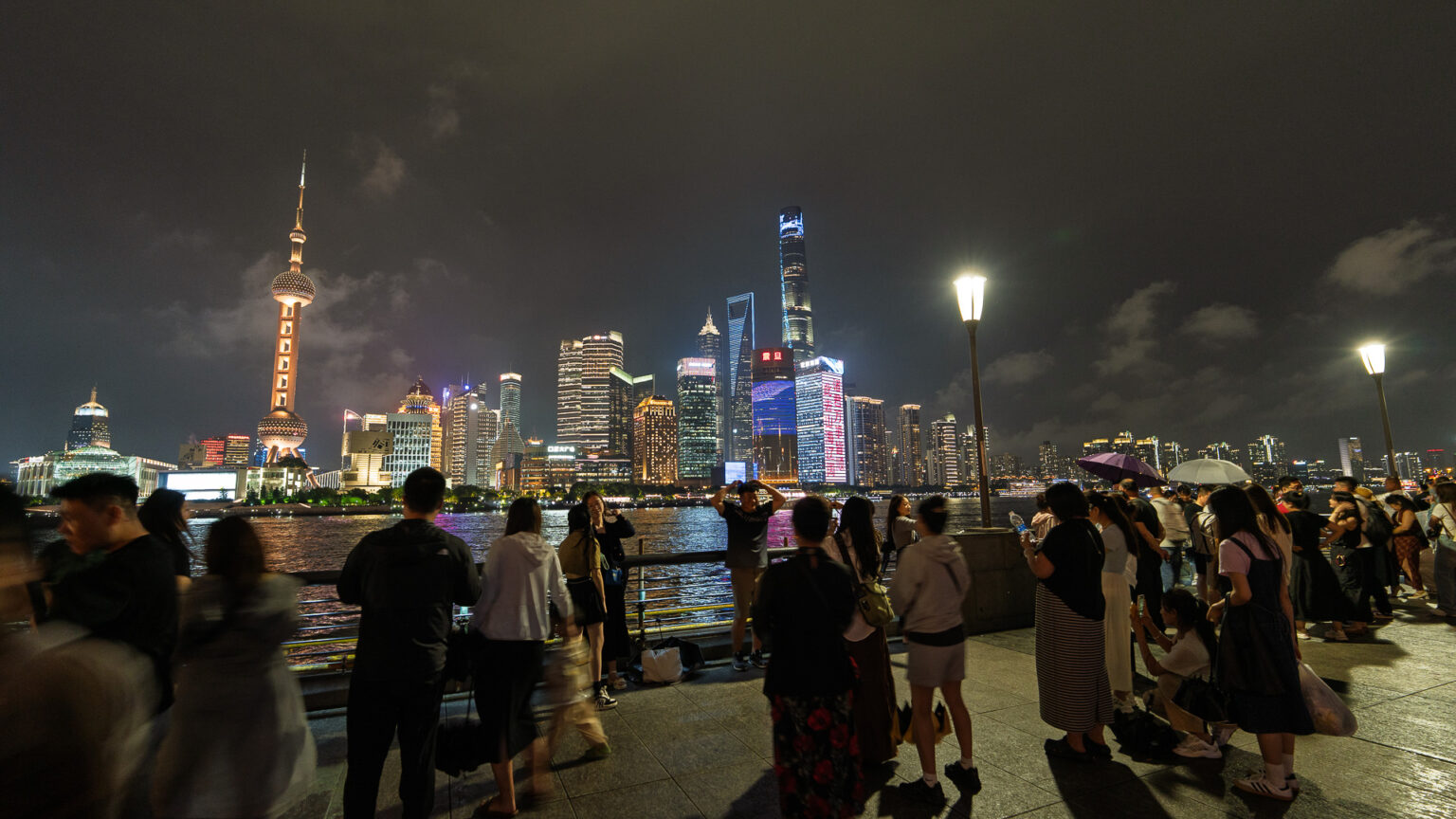We visited Shanghai for the first time in 2017. It was a pretty short stay that time too, but we did manage to see The Bund and go to the top of Shanghai Tower for epic city views. This time our time in Shanghai was generally unplanned. It was a buffer day before starting our planned travel itinerary farther into China. Since we’re somewhat seasoned travelers we were able to make great use of our free day.
It’s rainy season now in this part of the country and the day we arrived (June 9th 2025) it was foggy and the clouds were low in the sky. We arried at our hotel not long before sunset. I was looking forward to visiting The Bund again at night to see those wild lights on the skyscrapers. The prime viewing area was about a 30 minute work from our hotel. We ended up grabbing dinner at a Thai restaurant near our hotel and then walked over to The Bund.

The Bund
I’m no expert but my understanding is that the name of the area “The Bund” comes from the Hindi word “band” meaning “embankment” or “dyke”. That name was adopted by westerners during the colonial days lead by the British. It was a key port for shipping goods into and out of China and eventually became the an early financial and commerce hub.
The original development in the area was on the west side of the river, where the eastern side was all farmland. 30 years ago as China began to double down on reinventing itself into an international power house, development went into high gear on the east bank. Today, the eastern side is where many of the major international corporate sky scrapers, and high end real estate are. It is home to what was for a time the tallest building in the world, Shanghai Tower.
Our first night in town you couldn’t really see Shanghai Tower because of the low clouds but on the second day the clouds were much higher so you could see everything in it’s full majesty.
Shanghai Metro
The weather on day two was dreary and rainy so we decided it seemed like a great afternoon to check out a museum. After poking around using the China friendly AMap app i saw that there was a “World Expo Museum” not far from where we were staying. It was too far to walk, but the metro ride didn’t seem to difficult so we decided to give another international metro system a shot.
Similar to Japan, China also has a digital transit card that you can add directly from Apple Wallet. However, unfortunately for us foreigners, you have to have a Chinese cell phone number to fund it. However all was not lost, because there is another digital option. Foreigners can use Alipay directly at the Shanghai metro entry points. Not quiet as efficient as Suica in Japan but scanning the QR code is still pretty quick. Just need to remember to open your app before getting to the gate.
The trains themselves are very nice and modern. Though they do lack the *outstanding* dynamic stop information that Tokyo has, they are very clean and comfortable. Also, the announcements of the rail stops are both in mandarin and English so with a bit of patience i found it quite easy to navigate.
World Expo Museum
As a kid, my dad used to work construction and when i was 12 or so he was working on the World’s Fair that took place in New Orleans in 1984. I’ve been pretty intrigued by the fairs since then.
China hosted the global event for the first time in 2010 in Shanghai. It was a proud time for the county and clearly a great moment for their national heritage. In 2017 a museum highlighting the history of the fairs was open to the public.
The building which houses the exhibits is absolutely breathtaking. What an incredible work of art and engineering. The exhibitions themselves share details about a number of particularly noteworthy fairs and highlights a some of the key world debut. ( and yes for you STL folks, the debut of Ice Cream in 1904 was not overlooked).
It was a cool museum and kind of unusual to see a museum that showcase global history but is focused on achievements and development and not war. I really enjoyed it.
Rideshare in China (Didi and Dinner)
Later yesterday evening, I wanted to head back to The Bund but was also not exactly in the mood for Chinese food (I figure we’ll be eating it for weeks so i wanted to take the opportunity to have something different. ). I’d remembered seeing a Spanish restaurant on our walk the previous night. It was about a 30 minute walk from our hotel. Since it was raining and we’d probably end up wanting to walk back we decided to try another mode of transportation in China. China doesn’t have Uber but they do have ride share. They use Didi. But be aware, China doesn’t use the same Didi app that other parts of the world uses. There is a separate version for China. Fortunately for us foreigners, it has enough English to be understood, and you can pay for your ride with foreign funds. That said, i was not able to get it to pay for my ride with my US credit card. I ended up using Alipay to pay within Didi and that seemed to work. If you’ve used Uber, Lyft or Didi elsewhere you’ll find most of the experience familiar but with one really weird exception. For some reason, you pay for your ride *after* you’ve arrived at your destination! I didn’t realize that beforehand. After arriving at the restaurant i looked at the app to see if i could rate my driver (who shuttled us in a meticulously clean white Volkswagen). But once in the app I saw that the ride wasn’t paid for yet. As i said earlier, for some reason my credit card wouldn’t work but Alipay did. You basically launch Alipay from the Didi payment screen.
Leaving Shanghai
We’re currently on a highspeed train heading towards Huangshan and the Yellow Mountains. It’s rainy season and probably not an ideal time for a visit but, i’m sure we’ll have fun. The scenery whizzing by at 300kph is wonderful and fascinating. Towns, villages, rivers… lush green mountains… we’re zipping through tunnels that cut a path into the mountains and then through gorgeous valleys with the mountains peaking out from the clouds and mist.
The US really missed the boat in not building high speed rail infrastructure. It’s just easier than traveling by air and almost as fast. The journey from Shanghai to where we are now in Huangshan used to take 13 hours via conventional train. Now it’s less than 3.
We’ll be in this area for the next few days before heading farther west.


